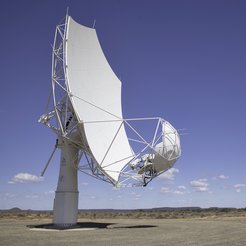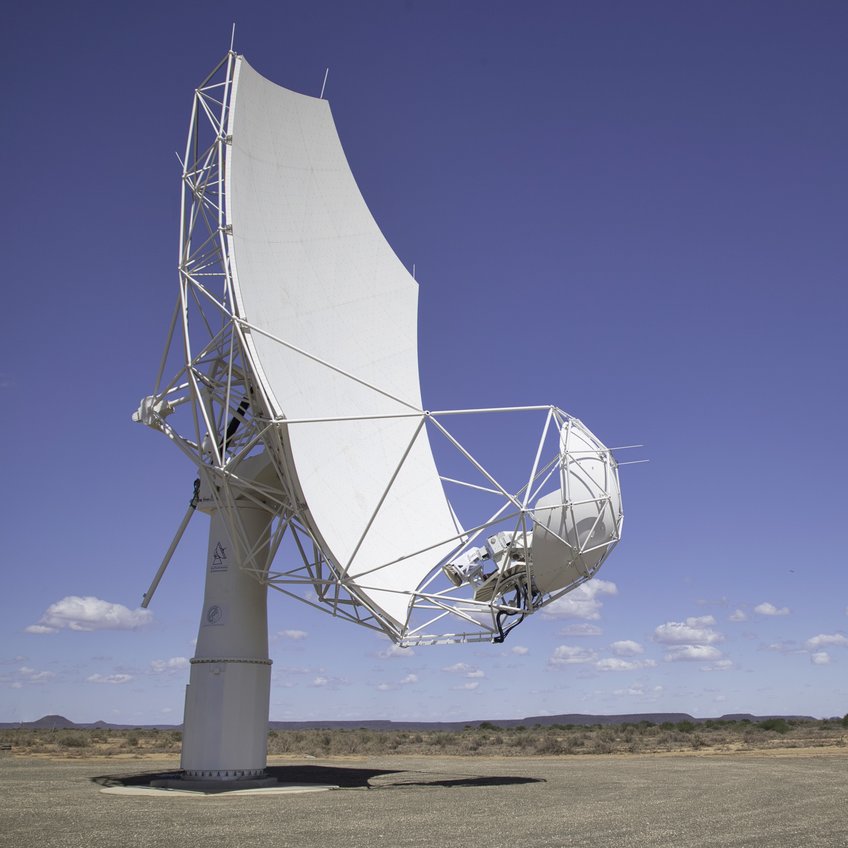INAF joins the MeerKAT+ Project
The South African Radio Astronomy Observatory and the Max-Planck-Gesellschaft welcome the Italian Istituto Nazionale di Astrofisica as partner on the MeerKAT extension project

The SKA-Max Planck Dish Demonstrator operating at the South African SKA site in the Karoo desert. The antenna provides a testbed for the extension of the MeerKAT telescope array within the MeerKAT+ project.
MeerKAT+ will see 20 new dishes being added to the existing array of 64 dishes, a joint project initiated and funded by SARAO and the MPG.
INAF will support MeerKAT+ with an additional financial investment of €6-million. As a result, MeerKAT+ will not only see improved scientific capability, but will also benefit through the scientific participation of INAF.
The MeerKAT project currently has 64 dishes, and the extension will see this number rise to 84. Importantly, the extension will result in the maximum distance between the dishes increasing from 8km to 17km, a move that will increase both MeerKAT’s sensitivity and its ability to capture higher definition radio images. The telescope’s computing requirements will also increase tenfold following these improvements.
MeerKAT+ would be an even more powerful telescope to study the formation and evolution of galaxies throughout the history of the universe.
The extended MeerKAT will increase the raw sensitivity of the instruments by about 50%, a move that will enable the telescope to survey the sky faster, and also enable it to detect even faintest astronomical sources.
MeerKAT+ will eventually be integrated into SKA1-Mid, the first phase of the SKA telescope, which will be an array of 197 dishes.
The MeerKAT+ project was initiated in 2019, and proceeded with thorough scientific evaluation and technical planning. Major tendering for MeerKAT+ is on its way, and first installation activities on site are scheduled for the middle of 2021. Integration and science commissioning of MeerKAT+ is expected to commence in 2023.
----------------------------------------------------
Additional Information
The South African Radio Astronomy Observatory (SARAO), a facility of the National Research Foundation, is responsible for managing all radio astronomy initiatives and facilities in South Africa, including the MeerKAT Radio Telescope in the Karoo, and the Geodesy and VLBI activities at the HartRAO facility. SARAO also coordinates the African Very Long Baseline Interferometry Network (AVN) for the eight SKA partner countries in Africa, as well as South Africa’s contribution to the infrastructure and engineering planning for the Square Kilometre Array Radio Telescope (SKA).
The Max-Planck-Gesellschaft (MPG) is a non-profit organisation with 86 institutes and research facilities. Among the society’s institutes is the Max-Planck-Institut für Radioastronomie (MPIfR) as a key player in the SKA’s Dish engineering consortium. Together with German industry partners, such as the telescope antenna specialists MT Mechatronics (MTM), and international partners, the Dish consortium is responsible for designing the SKA’s mid-frequency array (SKA-Mid). The MPIfR and MPG have already invested 16 million Euros into MeerKAT earlier in partnership with SARAO to provide a complete state-of-the-art receiver system for all 64 MeerKAT dishes with a so-called beamformer and a high-performance computer cluster to detect radio pulsars and transients, and also for the SKA-DISH demonstrator.
The Istituto Nazionale di Astrofisica (INAF is the main Italian research institute for the study of the Universe, founded in 1999. INAF funds and operates seventeen separate research facilities, which in turn employ scientists, engineers and technical staff. The research they perform covers most areas of astronomy, ranging from planetary science to cosmology.
The Square Kilometre Array (SKA) project is an international effort to build the world’s largest radio telescope, with a square kilometre (one million square metres) of collecting area. The SKA telescope will be co-located in Africa and in Australia. It will have an unprecedented scope in observations, exceeding the image resolution quality of the Hubble Space Telescope by a factor of 50 times, whilst also having the ability to image huge areas of sky in parallel.
